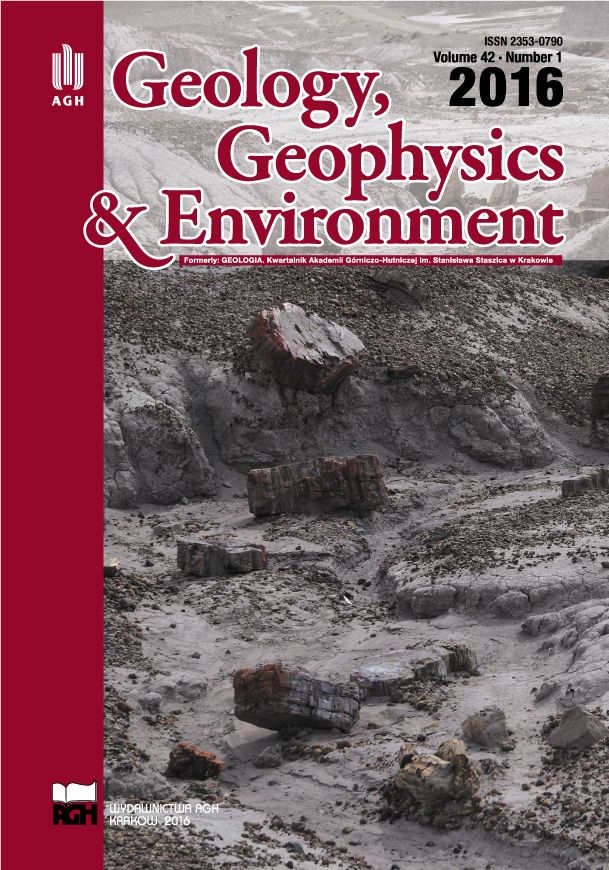Late Messinian palynoflora from Central Anatolian Plateau (Çankırı Basin)
DOI:
https://doi.org/10.7494/geol.2016.42.1.57Abstract
ABSTRACT
Within the framework of the Marie Curie FP7-PEOPLE-2013-ITN program, the ALErT project targets on tectonic and climatic boundary conditions in the regions along the densely populated in the Central Anatolian Plateau and the associated with natural hazards. The Central Anatolian Plateau (CAP) extends in a wide area in between zone the Aegean extensional zone and Bitlis /Zagros compressional zone. The Çankırı Basin was opened in Late Cretaceous between the Kırşehir block in the south and Sakarya continents in the north in central Anatolia. During the Neo-Tethys closure, the history of the basin became a large intermontane basin which covered with continental sedimentary environments (Kazancı et al., 1999). During the Late Miocene, there were different types of lacustrine environments in between the northern and southern parts. Age evidence of the Çankırı Basin has been obtained from the European mammalian faunal zones, because of the fact that Sr analysis results has not be significant to interpreted age (Mazzini 2015) and based on this, the late Messinian age Bozkır Formation and the Plio – Quaternary Değim Formation have seasonally dominant aridity.
To figure out the paleoenvironmental and palaeoclimate changes in Çankırı Basin were analyzed Biotic (Paynology) and abiotic proxy data (geochemical, δ18O - δ13C isotopes analyses and CaCO3). Fifteen samples from Hancili Formation, Tuglu Suleymanli crossing border, Bozkır Formation and Değim Formation were collected from claystone, dark silty clay, gypsum and breccia with silty gypsum layers in the Çankırı Basin. The samples were treated standard palynological procedures described by Cour (1974). For pollen step all samples, residues, and slides are stored in Comenius University in Bratislava, Slovakia. Pollen grains for each sample were accounted 150 pollen grains, without Pinus in the Çankırı Basin. Pollen identification was performed under a Zeiss light microscope, and under a Quanta FEG250 Scanning electron microscope (SEM) used for high resolution imaging of pollen grains in Institute of Electrical Engineering Slovak Academy of Sciences. The pollen diagram was prepared with Tilia*Graph (2.0) (http://www.chrono.qub.ac.uk/datah/tilia.html).
According to Mosbrugger and Utescher (1997); coexistence approach derived quantative paleoclimate parameters. To explain the ecological characteristic, we used version of the Past 3.x- the Past of the Future free software scientific statistical data analysis program (http://folk.uio.no/ohammer/past/). Head map was prepared with this program for four formations. Palynological data by evaluating head map, the uplift during the Late Messinian in Çankırı Basin has been confirmed. To illustrate for those vegetational composition, we applied Xact 8 for the graphic presentation. According to Traverse (1978) developed Steppe-Forest Index using a ratio of appropriate species of pollen, that save as a climatic indicator (warm to cold) on the other hand interpretation of aridity we follow Cour & Duzer (1978). As a consequence, the Poaceae/total Asteraceae ratio in a pollen diagram can be used as a climate index used Poaceae /Asteraceae ratio to find out dry to wet zones lines (Popescu, 2006) and it was calculated based on palynological results (using cluster analysis) show four climate cycles with three dry periods. Based on those calculations we confirmed long term cooling trend during Late Messinian to Plio-Pleistocene in Çankırı Basin. In most pollen spectra are mainly presented by Asteraceae, Chenopodiaceae, and Poaceae and by trees with Pinus, Cathaya, and Fagus. The group of herbs is important in the pollen sum and mainly consist of Poaceae, Chenopodiaceae and Asteraceae, which document open grassland type of vegetation with warm – temperate climate.
Downloads
References
References
Cour, P., 1974. Nouvelle technique de détection des fluxes et rétombées polliniques: étude de la sédimentation des pollens et des spores â la surface du sol. Pollen et Spores 16:pp 103-141.
Cour, P., Duzer, D., 1978. La signification climatique, édaphique et sédimentologique des rapports entre taxons en analyse pollinique. Annual Mines Belg. 7–8, pp 155–164.
Kazancı, N. and Varol, B., 1999. Development of a mass flow-dominated fan-delta complex and associated carbonate reefs within a transgressive Paleocene succession, Central Anatolia, Turkey. Sedimentary Geology, 68, pp. 261–278.
Mazzini, I., Gliozzi, E., Cosentino, D., Kovacova, M., Atalar, M., Castorina, F. and Mastro, L., 2015. Ostracoda from a late Messinian sabkha environment in the central Anatolia Plateau (Çankiri Basin, Turkey). Tartu Estonia EOM8 conference paper.
Mosbrugger, V., Utescher, T., (1997). The coexistence approach–a method for quantitative reconstructions of Tertiary terrestrial paleoclimate data using the plant fossils. Palaeog Palaeoc Palaeoe 134: pp 61–86.
Popescu M.S., 2006. Late Miocene and early Pliocene environments in the southwestern Black Sea region from high-resolution palynology of DSDP Site 380A (Leg 42B). Palaeogeography, Palaeoclimatology, Palaeoecology xx (2006) xxx–xxx.
Traverse, A., 1978. Palynological analysis of DSDP Leg 42B (1975) cores from Black Sea: Initial Reports of the Deep Sea Drilling Project, U.S. Government Printing Office, Washington D.C., 42B, pp 993-1015.
Downloads
Published
Issue
Section
License
Authors have full copyright and property rights to their work. Their copyrights to store the work, duplicate it in printing (as well as in the form of a digital CD recording), to make it available in the digital form, on the Internet and putting into circulation multiplied copies of the work worldwide are unlimited.
The content of the journal is freely available according to the Creative Commons License Attribution 4.0 International (CC BY 4.0)










